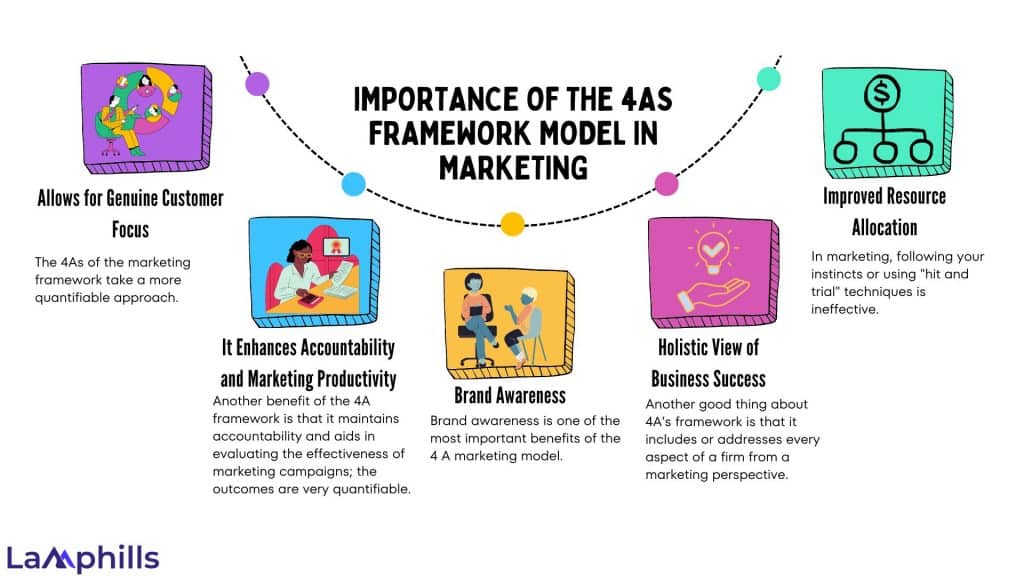In this digital era, marketing is more difficult than before. Launching a new product with the help of ads and PR events is not enough because now people are smarter about what they buy and why. Today’s customers expect businesses to always operate with high transparency since they know what they buy.
Effective product marketing requires an integrated strategy that considers all the variables affecting the product’s performance. Ultimately, initiating a marketing campaign without a strategy rarely yields the intended outcomes. This is why applying the 4A framework is one of the best marketing strategies. This article will explore the 4A marketing framework and its benefits.
Key Points
- The 4A framework of marketing, often referred to as the rural marketing mix, is a framework that highlights four essential elements that businesses and marketing professionals should consider to succeed in their marketing efforts.
- Effective product marketing requires a comprehensive strategy, and the 4A framework (acceptability, affordability, accessibility, and awareness) offers a structured approach to success.
- Benefits of the 4A marketing model include a customer-centric focus, enhanced accountability, brand awareness, a holistic business view, and improved resource allocation.
- Sectors that benefit from this marketing model include retail & e-commerce, consumer goods, healthcare, technology, and financial services.
What Is the 4A Framework of Marketing?
The 4A framework of marketing, often referred to as the rural marketing mix, is a framework that highlights four essential elements that businesses and marketing professionals should consider to succeed in their marketing efforts. These four pillars serve as cornerstones in delivering value that meets and exceeds customer expectations. They represent the critical elements businesses must consider to effectively resonate with their target audience.
The 4 A’s marketing framework means;
- Acceptability
- Affordability
- Accessibility
- Awareness
The core objective of the 4 A’s is to give entrepreneurs, managers, and businesses better insight into customers’ perceptions. Eventually, the customer will take on different roles, such as user, payer, and selector.
The 4 A’s framework of marketing concept states that these four elements are mandatory for the success of a product that can offer value to customers, society, and businesses. Let’s discuss every A of 4 A’s marketing framework in detail.
Components of the 4A Marketing Model
Here are the components of these marketing models:
#1. Accessibility
This goes beyond the mere presence of products or services in the market. It encompasses the ease with which customers can obtain and use what you offer. The digital age has expanded the notion of accessibility, making it crucial for businesses to have a robust online presence and to ensure their offerings are readily available through various channels.
Types of Accessibility in the 4 A’s of Marketing
Customer Convenience
Customer convenience is the ease with which a client can purchase or use a product or service. Human psychology is pretty simple; customers always prefer the most accessible options. The former chairman of Coca-Cola used the phrase “an arm’s length of desire” to highlight the significance of providing the product to prospective customers easily.
7-Eleven is the definition of customer convenience. The corporation opened thousands of locations to ensure clients could find and readily identify them.
Customer Availability
Availability here means whether the specific company has enough stock of a product to meet customers/market demand. If a customer wants a product at any given time while the company is out of stock, it will lead to customer dissatisfaction and force them to look for alternatives.
#2. Acceptability
When it comes to selling your goods, acceptability is crucial. Customer acceptance of your product is necessary for its success. Therefore, when creating a marketing strategy for your product, acceptance is a crucial factor to consider. Some factors that can impact the success of your venture are the product itself, its price, and how easy it is to use.
There are two types of this aspect, which are:
Functional Acceptability
Functional acceptability is the extent to which a good or service is acceptable to customers and satisfies their real needs. The individual needs certain needs to make decisions. Functional acceptability is crucial because it can predict a product or service’s likelihood of success. For example, a car with poor fuel efficiency would not be an acceptable product for most people.
Similarly, if a company makes products with low-quality materials that are not long-lasting and are difficult to repair, they would not be acceptable to most people. Functional acceptability also affects consumers’ willingness to pay for products. If a product is functional but not appealing, people may not value it highly enough to pay for it. This can make companies think twice about whether they should continue making that product.
Another important concept related to functional acceptability is the perceived usefulness of products or services to consumers, which refers to how well people think the product or service meets their needs. For example, a person who regularly uses an electric toothbrush might feel more comfortable paying more for a professional-grade electric toothbrush with excellent battery life than a cheaper model that does not last as long but works just as well.
Psychological Acceptability
Psychological acceptability is the extent to which a consumer perceives that a brand, product, or service is acceptable to them. It has a close relationship with how customers view quality. Acceptability generally relates to a consumer’s willingness or unwillingness to make a transaction. One way to define psychological acceptability is the ease with which customers can express favorable opinions about a product.
A product’s form factor, size, shape, and material are just a few of the variables that can influence psychological acceptability. Other factors include the brand image and perceived price. Psychological approval also depends on whether the consumer is in a social environment where the product is acceptable and useful.
#3. Affordability
This component takes a consumer-focused approach to the cost issue. It doesn’t always imply charging the lowest price on the market; rather, it is setting pricing that corresponds to the worth that customers believe your products to be worth. Striking a careful balance between competitive pricing and profitability is necessary.
There are two types of this aspect, which are:
Economical Affordability
Economic affordability refers to a customer’s financial ability to buy a specific product. Does your target customer have enough financial resources to buy your product? For example, a customer may want to buy a product from HSN or QVC but cannot unless these brands offer a six-easy payment method.
Affordability is important because it helps businesses create a product or service that is not only valuable but also cost-effective. Besides, affordability is more important when you develop your marketing campaign based on reliability and cost-effectiveness.
Psychological Affordability
Psychological affordability pertains to a customer’s willingness to pay for a specific good or service. Will they do so even while a client can make the purchase? This is contingent upon the customer’s perception of that particular product. Will he feel better after using the product? Or will it affect his or her acceptance by society or perhaps serve as a source of admiration or acceptance?
For example, oil field workers may prefer to drive a Chevy Bolt or Nissan LEAF because their peers drive tricked-out trucks.
#4. Awareness
Awareness is the first step in any marketing campaign. It’s the process of creating attention and interest in a product, service, or idea.
Being aware is crucial since it fosters trust with potential clients. If you know your business, people will likely trust and buy from you. There are various methods for raising awareness. Your company can be promoted online, on social media, at live events, and in other venues. Additionally, you can develop a devoted clientele by providing excellent goods and services at competitive costs.
Regardless of creating awareness for your business, you should always aim to improve upon it over time. It will allow you to build a strong brand identity for your organization and increase sales over time.
Types of Awareness in the 4 A’s of Marketing
Product knowledge
Product knowledge is the first step in the product development process, and it involves understanding what your customer wants and needs. It helps companies understand customer demographics, motivations, and buying patterns, and it also helps them improve their products and services.
Talking to prospective consumers is one approach to increasing product expertise. Through user feedback and sales trend analysis, companies can use surveys and other research tools to better understand their customers’ demands.
Product knowledge is essential for a company’s growth strategy and revenue. By knowing what customers want, companies are better able to create innovative products that meet their needs while also generating income. Knowing what customers want can also help companies identify new ways to reach customers or increase sales of existing products and services.
Brand Awareness
It is the foundation for creating an effective marketing strategy. It is essentially the number of people who know about your products or services. If people don’t know about your business, they can’t become your potential customers.
To build brand awareness, you should do three things: tell people about your company, tell them about your product or service, and tell them why it’s good.
Getting potential clients to recognize your business and desire to buy from you is the primary objective of every marketing strategy. To accomplish that, you must inform people about your company, the products you sell online and off, and why they should purchase from you.
Most importantly, be yourself when you talk about your business. People will not trust you if your brand approach seems fake or if you try too hard to impress them with fancy wording and a slick presentation.
To help you implement these principles in your own business, download our comprehensive 4A Framework Marketing Strategy Template below
Lamphills 4A Framework Marketing Strategy Template
Importance of the 4As Framework Model in Marketing

A strategic framework called the 4As of marketing can help you achieve greater success. The 4As of marketing are now considered the industry standard for business and marketing strategies. The following are a few benefits of the model:
#1. Allows for Genuine Customer Focus
The 4As of the marketing framework take a more quantifiable approach. In other words, rather than relying solely on a traditional marketing campaign, they assist organizations in creating a more measurable marketing mix.
This framework does not focus on when and where to sell your products. Instead, it helps businesses understand why people buy a certain product and what can affect the success of that product or service.
Also, when a business focuses on developing customer-driven strategies, it doesn’t have to go for “hard selling” techniques.
#2. It Enhances Accountability and Marketing Productivity
Another benefit of the 4A framework is that it maintains accountability and aids in evaluating the effectiveness of marketing campaigns; the outcomes are very quantifiable. This means that a company can quickly assess which marketing effort is effective and which isn’t with the aid of the 4A framework. In fact, a product may be rejected if it does not meet the 4A’s requirements with excellence.
#3. Brand Awareness
Brand awareness is one of the most important benefits of the 4 A marketing model. If potential customers are unaware of a company’s products or services, they cannot purchase them. The 4A marketing model helps increase brand awareness by reaching potential customers through various channels, such as advertising, public relations, and social media.
Read also: Top 15 Strategies to Increase Your Brand Awareness
#4. Holistic View of Business Success
Another good thing about 4A’s framework is that it includes or addresses every aspect of a firm from a marketing perspective. When a firm channelizes all its activities towards customer-driven and easily measurable objectives, it gives more freedom to its management and brings more productivity. Moreover, it urges the leadership to maximize individual and collective efforts to achieve organizational goals.
#5. Improved Resource Allocation
In marketing, following your instincts or using “hit and trial” techniques is ineffective. The 4A’s marketing strategy is particularly effective because it helps organizations allocate resources more effectively. It allows management to determine a marketing campaign’s advantages and disadvantages and then direct resources appropriately.
Industries That Can Benefit From the 4A’s of Marketing
There are numerous fields and businesses where the 4A’s of marketing can be implemented. The principles are universal and can be tailored to suit each sector’s specific needs and characteristics. Here are some sectors where the 4A’s of marketing are commonly applied:
#1. Retail & E-commerce
- Awareness: Creating campaigns to increase product visibility.
- Availability: Expanding online and physical presence.
- Affordability: Offering discounts, loyalty programs, and flexible payment options.
- Acceptability: Personalizing products based on customer preferences and feedback.
#2. Consumer Goods
- Awareness: Building brand recognition through advertising.
- Availability: Ensuring products are accessible in multiple locations.
- Affordability: Offering a range of price points to target various income levels.
- Acceptability: Tailoring products to cultural preferences and local tastes.
#3. Healthcare
- Awareness: Promoting services through digital and offline channels.
- Availability: Expanding the reach of clinics and telehealth options.
- Affordability: Providing flexible healthcare plans.
- Acceptability: Ensuring cultural sensitivity and personalized care.
#4. Technology
- Awareness: Leveraging digital marketing to reach tech-savvy consumers.
- Availability: Expanding access through online platforms and retail partnerships.
- Affordability: Offering subscription models or budget-friendly options.
- Acceptability: Creating user-friendly products that meet customer needs.
#5. Financial Services
- Awareness: Educating potential customers on financial products.
- Availability: Expanding branch networks and online services.
- Affordability: Offering tailored financial products with competitive rates.
- Acceptability: Building trust through transparency and excellent customer service.
What Are the 4PS in Marketing?
Bottom Line
In conclusion, the 4A framework marketing model considers the buyer-centric marketing idea, which originated in the digital marketing industry and was modified based on statistics and experience for the business-to-business (b2b) market. It focuses on the entire process of engaging the target audience and delivering marketing strategies.
The marketing goals are to increase brand recognition, attract new clients, and retain existing ones. The main objectives of the marketing cycle’s following components are building a community of brand champions, enlisting them as brand ambassadors, and monitoring and maximizing engagement levels on behalf of the brand.
The 4A marketing model is a great way to think about the marketing process, but there is much more. It can also be considered the foundation for the marketing strategy.
Similar Articles
- How I Build a Social Media Marketing Dashboard for Brands in 2024
- Must-Read Digital Marketing Books: Top Picks to Boost Your Strategy in 2024
- Top 4 Flywheel Marketing Strategies You Need to Know Now






